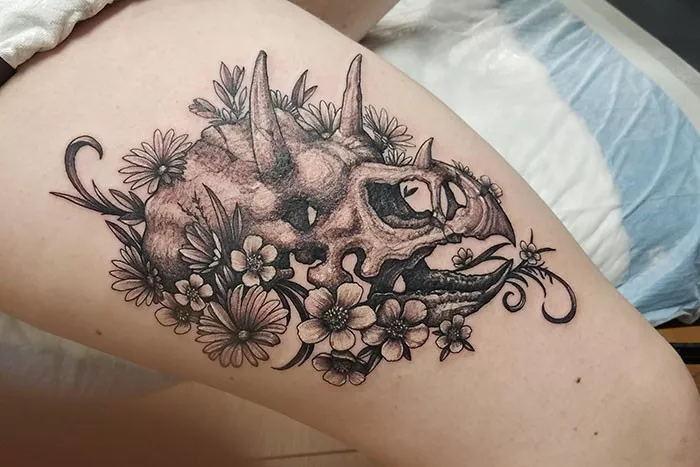Getting a tattoo is an exciting experience, but it also comes with a set of important aftercare instructions. One common concern for many people is how to handle showers after getting a tattoo. Proper care is crucial to ensure that your tattoo heals well and maintains its appearance. In this comprehensive guide, we will cover everything you need to know about showering after getting a tattoo, including timing, techniques, products, drying, aftercare, and the importance of avoiding certain water-related activities.
Can You Shower When You Get a Tattoo?
One of the first questions people have after getting a tattoo is how long they need to wait before taking a shower. The timing for your first shower can vary based on several factors, including the type of tattoo, the advice of your tattoo artist, and the type of bandage used.
Typically, tattoo artists will recommend waiting anywhere from 3 to 24 hours before taking your first shower. This timeframe allows the initial healing process to begin and helps prevent the bandage from becoming saturated with water. Here are a few guidelines to consider:
Immediate Aftercare: Most tattoo artists will cover your new tattoo with a bandage or plastic wrap. This cover protects the tattoo from bacteria and keeps it clean until the first wash. Follow your artist’s advice on how long to keep this bandage on, as it varies depending on the size and location of the tattoo.
Artist’s Advice: Always follow the specific advice given by your tattoo artist. They will consider factors such as the tattoo’s location and size, as well as the type of bandage used, when providing recommendations for your first shower.
Bandage Type: If your tattoo was covered with a specialized breathable bandage, you may be able to shower sooner than if it was covered with a traditional bandage. Be sure to ask your tattoo artist about the appropriate timing for your first shower based on the bandage used.
Showering Techniques
Once you’ve reached the appropriate time to shower, it’s important to follow specific techniques to ensure that you do not damage your tattoo. Proper showering techniques help minimize irritation and support the healing process.
Water Temperature
Use lukewarm or cool water for your shower instead of hot water. Hot water can increase irritation and may cause your tattoo to become inflamed or excessively dry. Lukewarm water is gentle on the skin and helps maintain a comfortable temperature for the healing tattoo.
Water Pressure
It’s crucial to avoid direct water pressure on the tattoo. Instead of letting the showerhead blast water directly onto the tattoo, allow the water to gently run over the area. Alternatively, you can use your hand to cup water and gently rinse the tattooed area. This technique minimizes the risk of washing away essential healing elements or causing irritation.
SEE ALSO: 5 Things to Do with Henna Tattoo After It Dries
Products to Use
Selecting the right products for cleaning and caring for your tattoo is essential. Using inappropriate products can lead to irritation, infection, or delayed healing.
Mild, Fragrance-Free Soap: Use a mild, fragrance-free soap to clean the tattooed area. Fragrance-free soaps are less likely to cause irritation or allergic reactions. Harsh soaps or those with strong fragrances can dry out the skin and disrupt the healing process.
Avoiding Abrasive Cleaning Tools: Avoid using loofahs, sponges, or washcloths on your tattoo. These items can be abrasive and may cause irritation or infection. Instead, use your clean hands to gently wash the area.
Drying the Tattoo
Properly drying your tattoo after a shower is an important step in the aftercare process. How you dry your tattoo can impact its healing and appearance.
Pat Dry, Don’t Rub: Gently pat the tattoo dry with a clean towel or paper towel. Avoid rubbing the tattoo, as this can cause irritation or damage to the healing skin. The patting motion helps absorb excess moisture without disturbing the tattoo.
Aftercare Post-Shower
After your tattoo is clean and dry, proper aftercare helps ensure that it heals correctly and maintains its quality.
Applying Moisturizer
Thin Layer of Ointment: Apply a thin layer of unscented moisturizing ointment, such as Aquaphor or A&D ointment, to keep the tattoo hydrated and protected. This helps prevent the tattoo from becoming too dry and supports the healing process.
Transition to Lotion: As the tattoo begins to heal, transition to using an unscented lotion. This provides ongoing moisture while avoiding the heavy, greasy feel of ointment.
Avoid Submerging
No Baths, Pools, or Hot Tubs: Avoid soaking the tattoo in baths, swimming pools, hot tubs, or any other body of water. The extended exposure to water can increase the risk of infection and cause the tattoo to become damaged. Always wait until your tattoo is completely healed before engaging in these activities.
Conclusion
Caring for a new tattoo involves several important steps to ensure proper healing and maintain the tattoo’s appearance. Knowing when you can shower, how to use the right techniques, and the appropriate products for aftercare is crucial. By following these guidelines, you can support your tattoo’s healing process and enjoy its beauty for years to come.
Remember, always consult with your tattoo artist for personalized aftercare instructions, as they can provide the best advice based on the specifics of your tattoo and its location. Proper aftercare not only helps prevent complications but also ensures that your tattoo heals beautifully and remains a lasting work of art.
Related Topics

